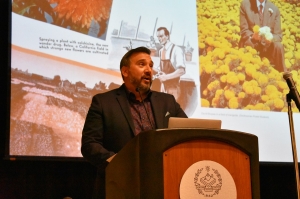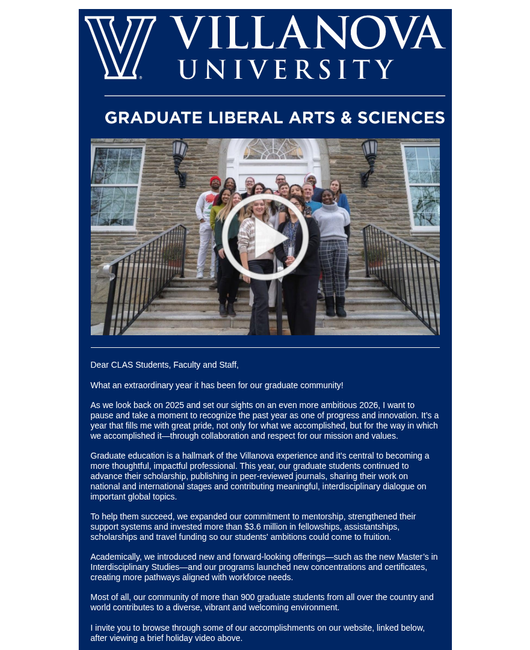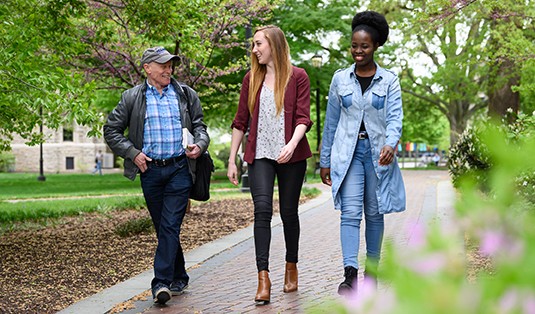Graduate Research Symposium Highlights Exceptional Student Work

Each spring, graduate students in CLAS apply for competitive Summer Research Fellowships to support their research. We are proud to present the exceptional research conducted by this select group of students.
The Third Annual Graduate Research Symposium was held on Friday, November 12, 2021, in the Connelly Center. Oral presentations took place from 1 to 2:30 p.m. in the Cinema and followed the Three Minute Thesis (3MT) format. Poster presentations ran concurrently from 2:30 to 4 p.m. in the St. David's Room.
Oral Presentations
| Opening Remarks Dean Emory Woodard, PhD |
|
| Social networks of mixed species chickadee flocks change with food accessibility Shane McFoy, Biology |
|
| Mathematical Modeling of Crime and its Deterrents: an Investigation of Prison, Policing and Collective Efficacy Gabrielle Coker, Math |
|
| David Burpee and the Marigold Makeover David McCauley, History |
|
| Synthesis of Functionalized Dihydropyrimidines for the Exploration of their Potential Antibiotic Activity Hannah Kessler, Chemistry |
|
| Through Roots and Binds: The Essence of Policing in Simone Weil Nathaniel Grimes, Theology |
|
| The Impact of Modeling Mental States on Goal-Directed Conversations Samuel Sinemus, Psychology |
|
| Examining the Relationship Between Autistic People’s Self-Esteem and Perceived Bias in their Alliance with their Mental Health Practitioners Zoe Darazsdi, Counseling |
|
| Aristotelianism and Technological Development Christopher Quintana, Philosophy |
|
| Impacts of impervious surface cover and road salt application on sodium and chloride concentrations in southeastern Pennsylvania streams Marissa Rossi, Environmental Science |
|
| Mobile app development: Evaluating FM radio signal propagation Nick Langan, Software Engineering |
|
| Understanding the transcription of Candida glabrata thiamine starvation-regulated promoters by characterizing the binding of transcription factor CgPDC2 Yakendra Bajgain, Biology |
|
| Conspiracy Theories and Party Politics in the Antebellum North Christopher DelSanto, History |
|
| Serotonin Deficiency Reduces the Magnitude of Antidepressant and Anxiolytic Behavioral Effects of Cardiovascular Exercise Allison Warner, Psychology |
|
| Environmental factors as predictors for peatland bryophyte assemblages of the Glaciated Pocono Plateau of Pennsylvania Joshua Zalewski, Biology |
Poster Presentations
Does social dominance of tufted titmouse asymmetrically impact black-capped versus Carolina chickadees?
Margaret Boyle, Biology
Determining the Role of Adenylate Cyclases in Crithidia fasciculata
Kelly Hodges, Biology
Modifying a Solid Oxide Fuel Cell Anode, Sr2Fe1.5Mo0.5O6-δ (SFMO), to Improve Redox Stability for Fuel Cell Applications Using Biofuels
Marissa Bradley, Chemistry
Liquid Chromatography-Tandem Mass Spectrometry (LC-MS/MS) Method for the Quantitation of Sulforaphane (SFN) in Human Plasma and Insights into Decomposition Pathways
Rachel Grady, Chemistry
Analysis and Characterization of Dissolved Organic Matter in Arctic Surface and Subsurface Waters
Amy Troutman, Chemistry
DiHD: Efficient classification of viral diseases from DNA Sequences using Hyperdimensional Computing
Bikal Lamichhane, Computer Science
Feminist Abolitionism Across Time
Em Friedman, English
Locating the Byzantine in Medieval English Literature: The Auchinleck Manuscript
Panagiotis Christoforos Sassaris, English
The Modern Revolution in Political Affect
Daniel Cunningham, Philosophy
Shift from Detailed to Gist-Like Memory Representations Across the Adult Lifespan
Alexa Gonzalez, Psychology
On God’s Ground: Desire, Identity Formation, and ‘Perverted Groups’ in Henry Suso’s The Life of the Servant
Ailie Posillico, Theology
About Villanova University’s College of Liberal Arts and Sciences: Since its founding in 1842, Villanova University’s College of Liberal Arts and Sciences has cultivated knowledge, understanding and intellectual courage for a purposeful life in a challenged and changing world. With 39 majors across the humanities, social sciences and natural sciences, it is the oldest and largest of Villanova’s colleges, serving more than 4,500 undergraduate and graduate students each year. The College is committed to a teacher-scholar model, offering outstanding undergraduate and graduate research opportunities and a rigorous core curriculum that prepares students to become critical thinkers, strong communicators and ethical leaders with a truly global perspective.


